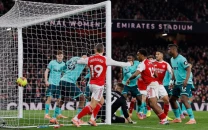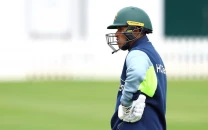World honours 'Golden Kid' Maradona on anniversary
Thursday marks one year since the death of Argentina’s legendary footballer
1637857215-0/MAR-(2)1637857215-0-640x480.webp)
The world on Thursday marked the one-year anniversary of the death of Diego Maradona, regarded by some as the best player of all time and a man adored in his home country Argentina despite, or perhaps because of, his human flaws.
Argentine club matches marked a minute of silence and player arranged themselves in a "10" formation on the pitch to honor Maradona's famous jersey number, while special masses were held -- including in the Buenos Aires slum where Maradona grew up, to mark the day he passed away.
In Naples, where he spent part of his career, two statues for the striker were unveiled.
"We'll miss you for the rest of our lives," said the Argentine Football League in homage on the eve of the anniversary, with a video of the life, goals, and many trophies of the man nicknamed "Pibe de Oro" (Golden Kid).
Maradona died of a heart attack last November at the age of 60, weeks after undergoing brain surgery for a blood clot.
The former Boca Juniors, Barcelona and Napoli star had battled cocaine and alcohol addictions for years, and was suffering from liver, kidney and cardiovascular disorders when he died.
His death shocked fans around the world, and tens of thousands queued to file past his coffin, draped in the Argentine flag, at the presidential palace in Buenos Aires during three days of national mourning.
He may be dead, but in Argentina Maradona is everywhere.
From ubiquitous mural frescos that portray him as a deity to television series about his life and even a religion bearing his name.
His two goals in the 1986 World Cup quarter-finals, which saw Argentina triumph over England just four years after the Falklands War, made Maradona an instant hero.
His rags-to-riches story, stellar sporting achievements, complicated life and dramatic death entrenched his place in the Argentine psyche.
In the cities, Maradona's name is memorialized in countless graffiti: "Diego lives”, "10 Eternal" and "D10S" -- a play of words with the Spanish word for god, "Dios", and Maradona's famous jersey number.
Murals in Buenos Aires depict him with angel wings, as a patron saint complete with halo and scepter, or back here on Earth, kissing the World Cup.
Maradona is perhaps remembered as much for his "Hand of God" goal -- which illegally came off his hand in what he ascribed to supernatural intervention -- as for his second in the same match against England which would later become known as the "Goal of the Century".
These extremes -- "a virtuous goal and a sinful goal" that also reflected Maradona's conflicted life of virtue and vice -- help explain people's fascination him, according to Latin American columnist Eduardo Galeano.



















COMMENTS
Comments are moderated and generally will be posted if they are on-topic and not abusive.
For more information, please see our Comments FAQ